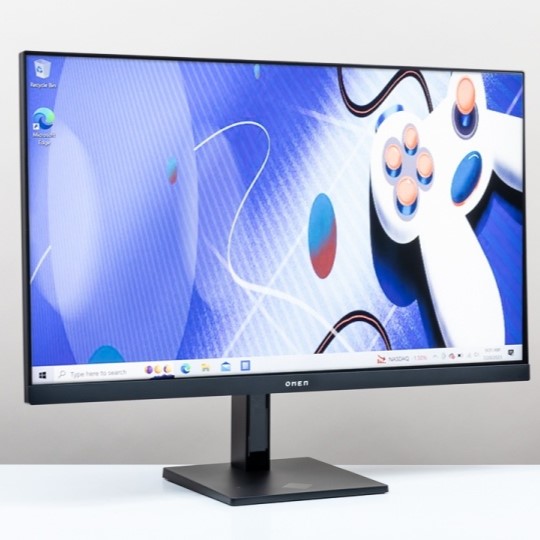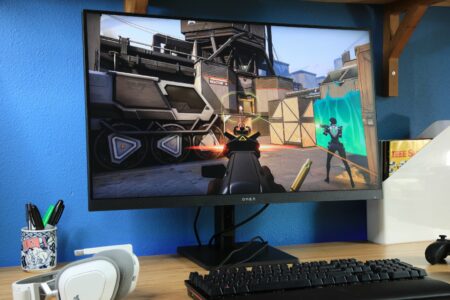CONS
- No built-in speakers
- No HDMI 2.1 port or additional USB ports
| Panel Size (Corner-to-Corner) |
32 inches |
| Native Resolution |
2560 by 1440 |
| Aspect Ratio |
16:9 |
HP has expanded its Omen gaming monitor lineup beyond the high-end 4K displays, such as the Omen 27k. They now offer a wide range of sizes, resolutions, and price options. One of these options is the HP Omen 32q, a 31.5-inch QHD monitor with a refresh rate of 165Hz. While it may not have any standout features, it does offer good brightness, HDR capabilities, and accurate color reproduction. Currentl it is an excellent choice for budget-conscious PC-desktop players and console gamers who prioritize performance over visuals.
The Design: A Minor Devil
The Omen 32q features a similar minimalist design to the Omen 27k, with an all-black body, a square stand, and the Omen logo located on the bottom bezel. Additionally, the 32q boasts the same diamond pattern on its back panel, but without the RGB lighting, OSD control stick, and some shortcut buttons found on the lower right side.
Whilst we are situated behind the monitor, let us discuss the ports. The Omen possesses a surprisingly limited number of ports, consisting of only two HDMI 2.0 ports, one DisplayPort, and a headphone jack. It is worth noting the absence of an HDMI 2.1 port, which may be disappointing for those who were anticipating the ability to achieve high frame rates with an Xbox Series X or PlayStation 5. However, it is important to mention that only a few games actually support this feature. Furthermore, the Omen 27k lacks a USB Type-C port, which typically functions as an additional DisplayPort. Additionally, there are no extra USB ports or built-in speakers available.
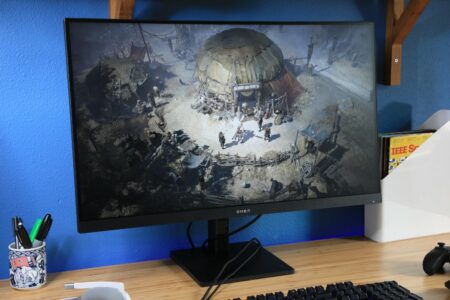
The exclusions may not be pleasant to acknowledge, however, they contribute to maintaining the Omen 32q well under . With its reduced cost, it presents a great value proposition considering its dimensions and display quality.
In terms of dimensions, the display measures 16.8 by 28.1 by 2.1 inches (HWD) and weighs just under 20 pounds. These measurements are typical for monitors in this category, slightly heavier than our affordable favorite, the NZXT Canvas 32Q, but lighter than the Lenovo Legion Y32p-30. Despite its limited port options, the Omen remains flexible with a good tilt range (-5 to +20 degrees) and the ability to switch between landscape and portrait orientations. However, it does not have a swivel feature on its base.
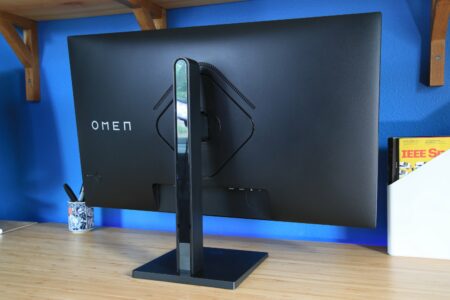
Let us now focus on the screen itself. The Omen 32q features an IPS gaming panel, similar to its 4K counterpart. IPS technology is commonly utilized in gaming monitors due to its tendency to offer lower response times, improved color accuracy, and broader viewing angles compared to VA panels. While they may not match the color vibrancy of OLED screens, IPS panels manage to avoid the high prices typically associated with OLED displays.
Once again, HP’s optimal price point entails removing several features from the list: 4K resolution, USB ports, speakers, RGB lighting, and an HDMI 2.1 port. Nevertheless, these exclusions do not impact the monitor’s performance. To substantiate this claim, let us refer to our objective tests.
The HP Omen 32q: Precision in Crucial Aspects
In order to assess the performance of the Omen 32q (as well as all other monitors), we conduct tests on color gamut, brightness, color accuracy, and contrast ratio utilizing our Calman monitor calibration software, a Murideo Six-G window signal generator, and a Klein K-80 colorimeter.
In the initial stage, the brightness of the display is measured by utilizing an SDR signal in its default picture mode. The Omen 32q achieved a brightness of 380 nits (candelas per square meter), which is slightly lower than its specified 400-nit brightness but comparable to the Omen 27k’s performance of 421 nits. However, when switching to an HDR signal, the 32q surpassed its DisplayHDR 400 rating and exhibited a brightness of 552 nits.
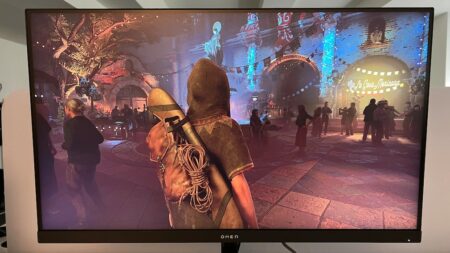
The Omen 32q displayed 95% of the sRGB palette, 71% of Adobe RGB, and 71% of DCI-P3 when considering its color-gamut coverage. These figures closely mirror the results we obtained from the Omen 27k. While these results are satisfactory for a budget display, the 99% RGB coverage promised by the monitor falls slightly short.
We then assess the precision of colors. The greater the Delta E value of a monitor, the further its colors deviate from their original shades. An ideal value is below 1, however, most gaming monitors typically fall closer to 2, particularly when using default settings. This was the case with the HP monitor, which displayed a Delta E of 2.1. For professional content creators and video editors, it is recommended to opt for monitors specifically designed for their needs, such as the ViewSonic VP2785-4K. Nevertheless, the performance of the Omen 32q is perfectly suitable for casual gaming straight out of the box.
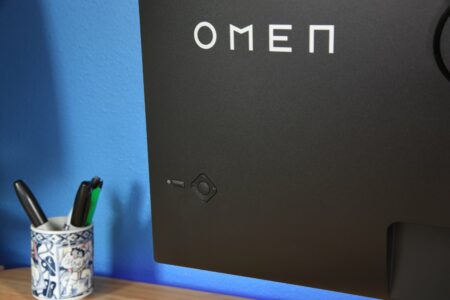
In our recent examination using the Klein colorimeter, we analyzed the contrast ratio of a screen, which refers to the variance in luminance between the brightest white and darkest black that a monitor is capable of displaying. The Omen 32q achieved a contrast ratio of 765:1, with a black level measuring at 0.57. While this result is satisfactory, it falls slightly below the static contrast ratio of 1,000:1 as stated on HP’s product page.
Performance in Gaming and Media
After completing our overall monitor assessments, we are now able to shift our attention to the crucial metric of any gaming monitor: its input lag. This is measured using an HDFury Diva HDMI matrix. Similar to the Omen 27k, the HP Omen 32q performed admirably, displaying less than 1 millisecond of input lag. This outcome is optimal for maintaining competitiveness in multiplayer games. Additionally, the monitor is equipped with AMD FreeSync Premium, which helps prevent potential screen tearing that could occur at varying, higher frame rates.
The Omen 32q’s peak refresh rate of 165Hz falls within the middle to lower range compared to current-gen gaming monitors, particularly with the rise of 240Hz panels. However, 165Hz monitors are suitable for midrange gaming setups, and it pairs perfectly with the HP’s 1440p resolution. Achieving 165fps at 1440p will require a powerful video card in most cutting-edge games. When playing fast-paced shooters like Counter-Strike: Global Offensive or Overwatch 2, you’ll notice that the display effortlessly keeps up with the action.
Verdict: A Positive Sign
HP’s engineers faced some challenging design choices when creating the Omen 32q. They decided to forgo RGB lighting, speakers, and an HDMI 2.1 port. However, these deliberate omissions actually enhance the value of the 32q, making it an excellent choice for gamers. Its remarkably low input lag, satisfactory color accuracy, and brightness contribute to its status as a dependable and reasonably priced option. Despite the absence of certain features, the 32q remains a compelling choice that is hard to ignore.
The HP Omen 32q is an affordable gaming monitor that caters to beginner PC builders, budget-conscious shoppers, and gamers who switch between console and PC gaming. While our top choice for QHD gaming display is the Corsair Xeneon 27QHD240 OLED, the HP Omen 32q offers solid performance at a lower price point, making it a great option for those who prioritize value over luxury.

